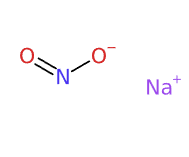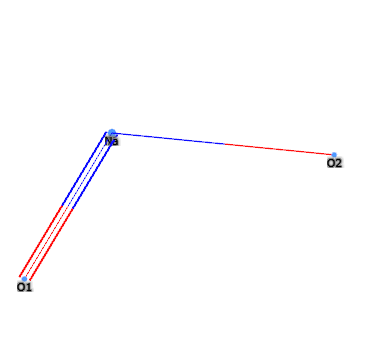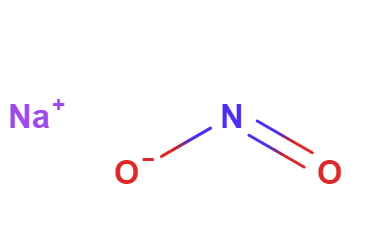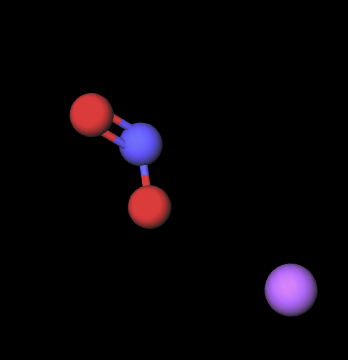| "Descrizione" by Ark90 (12471 pt) | 2025-Jul-06 16:42 |
Review Consensus: 10 Rating: 10 Number of users: 1
| Evaluation | N. Experts | Evaluation | N. Experts |
|---|---|---|---|
| 1 | 6 | ||
| 2 | 7 | ||
| 3 | 8 | ||
| 4 | 9 | ||
| 5 | 10 |
E250 (Nitrito di sodio) è un composto chimico, ione di sodio con sale di sodio inorganico e derivato fisiologico dell'ossido nitrico al quale può essere bioattivato. E' molto solubile in acqua e ammoniaca liquida, stabile in condizioni anaerobiche. Leggermente solubile in etere, etanolo, metanolo ed altri solventi organici. reagisce con l'ossigeno per formare nitrato di sodio quando è esposto all'aria.
Il nome definisce la struttura della molecola
- "Sodium" (Sodio). È un metallo alcalino, simbolo Na, con numero atomico 11. È un elemento essenziale per la vita e svolge un ruolo chiave nella regolazione della pressione sanguigna e del volume del plasma.
- "Nitrite". Si riferisce al sale o all'estere dell'acido nitroso e ha la formula chimica NO2-. I nitriti sono utilizzati come conservanti alimentari e come agenti antimicrobici.
Descrizione delle materie prime utilizzate nella sua produzione:
- Ossidi di Azoto (NO e NO2) - Questi gas sono generati durante le operazioni di combustione ad alte temperature.
- Idrossido di Sodio (NaOH) o Carbonato di Sodio (Na2CO3) - Questi reagenti alcalini reagiscono con gli ossidi di azoto per formare nitrito di sodio.
Sintesi industriale chimica del Nitrito di Sodio, passo dopo passo:
- Produzione di Ossidi di Azoto - Durante la combustione a alte temperature, l'azoto e l'ossigeno dell'aria reagiscono per formare ossidi di azoto (NO e NO2).
- Assorbimento degli Ossidi di Azoto - Gli ossidi di azoto vengono assorbiti in una soluzione acquosa di idrossido di sodio (NaOH) o carbonato di sodio (Na2CO3). Questa reazione produce nitrito di sodio (NaNO2):
- Cristallizzazione - La soluzione di nitrito di sodio viene raffreddata per permettere la cristallizzazione del nitrito di sodio.
- Isolamento e Filtrazione - I cristalli di nitrito di sodio vengono separati dalla soluzione mediante filtrazione.
- Asciugatura - I cristalli filtrati vengono asciugati per rimuovere l'acqua residua.
Si presenta come polvere cristallina bianca o giallastra

A cosa serve e dove si usa
Viene utilizzato in medicina, alimentazione, fertilizzante, fissativo nei coloranti, insetticida biologico, antigelo, materia prima nella produzione di caffeina e saccarina, inibitore di corrosione dell'acciaio, agente sbiancante per seta e lino, agente di trattamento termico dei metalli, candeggio, galvanoplastica.
Cromatografia: per determinare mercurio, potassio e clorato. Reagente di nitrificazione e di diazotazione (generazione temporanea di nitrito di sodio e acido cloridrico). Analisi del suolo. Bilirubina sierica misurata nel test di funzionalità epatica.
Alimentazione
Ingrediente inserito nella lista degli additivi alimentari europei come E250, conservante.
Nitriti e nitrati vengono inseriti in carni lavorate per conferire loro una colorazione caratteristica e conservarli. Nel 1800 si usava il salnitro per la conservazione delle carni, ma è negli anni '50 e '60 che i nitriti vengono utilizzati regolarmente. Come alternativa si utilizzavano anche sali di sodio o sali di potassio.
L'uso del nitrito di sodio oggi è consentito ma a concentrazioni rigidamente stabilite dalla legislazione europea sugli additivi alimentari (Regolamento (CE) n. 1333/2008). Il nitrito di sodio è etichettato con il numero E250 nella lista degli additivi europei come conservante. E' soggetto a Dose Giornaliera Ammissibile (DGA) di 0-0,07 mg/kg di peso corporeo al giorno dall'SCF (1997) e dal JECFA (2002).
Il nitrito di sodio è un comune agente polimerizzante che svolge la sua azione protettiva contro l'ossidazione lipidica, tuttavia questo studio rileva che, da una parte, si assiste ad una rapida espansione dei prodotti a base di carne che utilizzano derivati naturali dei nitrati, per contro si assiste ad una fondamentale mancanza di comprensione per quanto riguarda la sicurezza e le implicazioni chimiche degli agenti polimerizzanti, sia derivati da fonti sintetiche che naturali. Un'elevata assunzione di nitriti comporta un rischio per i consumatori a causa degli effetti vasodilatatori e causa della produzione di nitrosammine cancerogene (1). I prodotti a base di carne trattati con nitrito di sodio, a seconda del metodo di lavorazione (invecchiamento, maturazione, fermentazione, affumicatura, trattamento termico e stoccaggio) possono essere contaminati da N-nitrosammine cancerogene (2).
In un rapporto del World Cancer Research Fund nel 2007 viene sottolineata l'importanza di limitare l'assunzione di carne rossa ed evitare carne lavorata in quanto prove convincenti portano ad un'associazione tra carne rossa lavorata e cancro (3) e questo studio, riferendosi ad un workshop tenutosi a Oslo in Norvegia nel novembre 2013 dove si è discusso di aspetto salutare della carne rossa e lavorata, pone l'attenzione su una dieta squilibrata a predominanza di carne rossa che può sviluppare il rischio di cancro del colon retto (4).
L'assunzione prolungata di grandi quantità di nitriti è associata ad un aumento del rischio di sviluppare il cancro allo stomaco e il cancro all'esofago. Gli alimenti contenenti nitrito di potassio (E249), nitrito di sodio (E250) e nitrato di potassio (E252) dovrebbero pertanto essere evitati o fortemente ridotti, soprattutto nella carne in scatola, nelle salsicce e nelle carni lavorate (5).
Nel 2017 il Panel on Food Additives and Nutrient Sources added to Food (ANS) ha fornito un parere scientifico sulla sicurezza del nitrito di sodio concludendo che ci sono prove per attribuire a NDMA (n-nitrosodimethylamine) un collegamento ai tumori del colon retto (6).
Cosmetica
Anticorrosivo. E' un ingrediente soggetto a restrizioni III/17 come Voce pertinente negli allegati del regolamento europeo sui cosmetici n. 1223/2009. Concentrazione massima nella preparazione pronta all'uso 0,2%. Non utilizzare con ammine secondarie e/o terziarie o altre sostanze che formano nitrosammine.
Applicazioni commerciali
Conservante in Prodotti Alimentari. Il nitrito di sodio viene utilizzato come conservante, specialmente in carni lavorate come salumi, per prevenire la crescita di batteri.
Colorante in Alimenti. Agisce come fissativo del colore nelle carni lavorate, contribuendo a mantenere un colore rosso attraente.
Inibitore della Corrosione. Utilizzato in soluzioni di raffreddamento di motori e altre applicazioni industriali per prevenire la corrosione dei metalli.
Reagente in Analisi Chimiche. Utilizzato come reagente in diversi test chimici per analizzare e determinare la presenza di composti specifici.
Produzione di Gomma. Utilizzato nella produzione di gomma come agente di maturazione per migliorare la resistenza e le proprietà di lavorazione.
Su questo ingrediente sono stati selezionati gli studi più rilevanti con una sintesi dei contenuti:
Caratteristiche tipiche ottimali del prodotto commerciale Nitrito di sodio
| Appearance | Colorless or yellow crystal |
| Content of sodium nitrite % | ≥98.5 |
| Boiling Point | 320 °C |
| Melting Point | 271 °C(lit.) |
| Density | 1.29 g/mL at 25 °C |
| PSA | 52.49000 |
| LogP | 0.25060 |
| Water Solubility | 820 g/L (20 ºC) |
| Water insoluble matter | ≤0.05% |
| Sodium nitrate | ≤0.8% |
| Chloride | ≤50ppm |
| Moisture % | ≤2.0 |
| Storage | 2-8°C |
| Safety |  |
 |  |
 |  |
- Formula molecolare: NNaO2
- Peso molecolare: 68.995
- Massa esatta 68.982674
- CAS 7632-00-0
- UNII M0KG633D4F
- EC Number 231-555-9
- DSSTox Substance ID DTXSID0020941
- IUPAC sodium;nitrite
- InChI=1S/HNO2.Na/c2-1-3;/h(H,2,3);/q;+1/p-1
- InChl Key LPXPTNMVRIOKMN-UHFFFAOYSA-M
- SMILES N(=O)[O-].[Na+]
- MDL number MFCD00011118
- PubChem Substance ID 329752451
- ChEBI 78870
- ICSC 1120
- NSC 77391
- RTECS RA1225000
- UN 1500 3287
Sinonimi:
- Nitrous acid, sodium salt
- Nitrite, Sodium
Bibliografia_____________________________________________________________________
(1) Rivera N, Bunning M, Martin J. Uncured-Labeled Meat Products Produced Using Plant-Derived Nitrates and Nitrites: Chemistry, Safety, and Regulatory Considerations. J Agric Food Chem. 2019 Jul 24;67(29):8074-8084. doi: 10.1021/acs.jafc.9b01826.
Abstract. Consumers often malign conventional curing agents while concomitantly accepting the natural forms of the same constituents in numerous food products. This paradox ostensibly exceeds all other food-related controversies to date and likely contributes to the rapid expansion of meat products that utilize natural nitrate derivatives. While there is high demand for these products, a fundamental lack of understanding regarding the safety and chemical implications of curing agents, whether derived from synthetic or natural sources, continues to persist. This manuscript elucidates the variations among curing preparations with particular emphasis pertaining to the associated safety, chemical, and regulatory ramifications encompassing these product categories.
(3) De Mey E, De Maere H, Paelinck H, Fraeye I. Volatile N-nitrosamines in meat products: Potential precursors, influence of processing, and mitigation strategies. Crit Rev Food Sci Nutr. 2017 Sep 2;57(13):2909-2923. doi: 10.1080/10408398.2015.1078769.
Abstract. Meat products can be contaminated with carcinogenic N-nitrosamines, which is ascribed to the reaction between a nitrosating agent, originating from nitrite or smoke, and a secondary amine, derived from protein and lipid degradation. Although in model systems it is demonstrated that many amine containing compounds can be converted to N-nitrosamines, the yield is dependent of reaction conditions (e.g., low pH and high temperature). In this article, the influence of the composition of the meat products (e.g., pH, aw, spices) and processing (e.g., ageing, ripening, fermentation, smoking, heat treatment and storage) on the presence and availability of the amine precursors and the N-nitrosamine formation mechanism is discussed. In addition, this article explores the current N-nitrosamine mitigation strategies in order to obtain healthier and more natural meat products.
(3) Demeyer D, Honikel K, De Smet S. The World Cancer Research Fund report 2007: A challenge for the meat processing industry. Meat Sci. 2008 Dec;80(4):953-9. doi: 10.1016/j.meatsci.2008.06.003.
Abstract. One of the 10 universal guidelines for healthy nutrition in a report of the World Cancer Research Fund released at the end of 2007 is to "limit intake of red meat and avoid processed meat", as a result of the "convincing evidence" for an association with an increased risk of colorectal cancer development. In the present paper, the scientific evidence for the association between processed meats intake and colorectal cancer development is explored and the most probable hypothesis on the mechanism underlying this relationship formulated. It seems that the present state of knowledge is not well understood but relates to a combination of haem iron, oxidative stress, formation of N-nitroso compounds and related residues in the digestive tract as the causal factors. Although criticisms of the inaccurate definition of processed meats and the insufficient accounting for the large variability in composition of meat products have been expressed, it is clear that the report urges proper action by the meat and nutrition research community and the meat industry. Research items that in our view should be addressed are discussed. They include: (1) evaluating the health risks associated with processed meats intake within the context of the supply of beneficial nutrients and other nutrition associated health risks; (2) definition of the role of nitrites and nitrates in meat processing; (3) investigating the role of red and processed meats on the endogenous formation of N-nitroso compounds in the digestive tract; and (4) developing improved processed meats using new ingredients.
(4) Oostindjer M, Alexander J, Amdam GV, Andersen G, Bryan NS, Chen D, Corpet DE, De Smet S, Dragsted LO, Haug A, Karlsson AH, Kleter G, de Kok TM, Kulseng B, Milkowski AL, Martin RJ, Pajari AM, Paulsen JE, Pickova J, Rudi K, Sødring M, Weed DL, Egelandsdal B. The role of red and processed meat in colorectal cancer development: a perspective. Meat Sci. 2014 Aug;97(4):583-96. doi: 10.1016/j.meatsci.2014.02.011.
Abstract. This paper is based on a workshop held in Oslo, Norway in November 2013, in which experts discussed how to reach consensus on the healthiness of red and processed meat. Recent nutritional recommendations include reducing intake of red and processed meat to reduce cancer risk, in particular colorectal cancer (CRC). Epidemiological and mechanistic data on associations between red and processed meat intake and CRC are inconsistent and underlying mechanisms are unclear. There is a need for further studies on differences between white and red meat, between processed and whole red meat and between different types of processed meats, as potential health risks may not be the same for all products. Better biomarkers of meat intake and of cancer occurrence and updated food composition databases are required for future studies. Modifying meat composition via animal feeding and breeding, improving meat processing by alternative methods such as adding phytochemicals and improving our diets in general are strategies that need to be followed up. Copyright © 2014. Published by Elsevier Ltd.
Haile D, Harding KL, McLaughlin SA, Ashbaugh C, Garcia V, Gilbertson NM, Kifle H, Parent MC, Sorensen RJD, Hay SI, Aravkin AY, Zheng P, Stanaway JD, Murray CJL, Brauer M. Health effects associated with consumption of processed meat, sugar-sweetened beverages and trans fatty acids: a Burden of Proof study. Nat Med. 2025 Jun 30. doi: 10.1038/s41591-025-03775-8.
Abstract. Previous research suggests detrimental health effects associated with consuming processed foods, including processed meats, sugar-sweetened beverages (SSBs) and trans fatty acids (TFAs). However, systematic characterization of the dose-response relationships between these foods and health outcomes is limited. Here, using Burden of Proof meta-regression methods, we evaluated the associations between processed meat, SSBs and TFAs and three chronic diseases: type 2 diabetes, ischemic heart disease (IHD) and colorectal cancer. We conservatively estimated that-relative to zero consumption-consuming processed meat (at 0.6-57 g d-1) was associated with at least an 11% average increase in type 2 diabetes risk and a 7% (at 0.78-55 g d-1) increase in colorectal cancer risk. SSB intake (at 1.5-390 g d-1) was associated with at least an 8% average increase in type 2 diabetes risk and a 2% (at 0-365 g d-1) increase in IHD risk. TFA consumption (at 0.25-2.56% of daily energy intake) was associated with at least a 3% average increase in IHD risk. These associations each received two-star ratings reflecting weak relationships or inconsistent input evidence, highlighting both the need for further research and-given the high burden of these chronic diseases-the merit of continuing to recommend limiting consumption of these foods. © 2025. The Author(s), under exclusive licence to Springer Nature America, Inc.
(5) http://www.airc.it/cancro/disinformazione/additivi-conservanti-alimentari/
(6) EFSA Panel on Food Additives and Nutrient Sources added to Food (ANS), Mortensen A, Aguilar F, Crebelli R, Di Domenico A, Dusemund B, Frutos MJ, Galtier P, Gott D, Gundert-Remy U, Lambré C, Leblanc JC, Lindtner O, Moldeus P, Mosesso P, Oskarsson A, Parent-Massin D, Stankovic I, Waalkens-Berendsen I, Woutersen RA, Wright M, van den Brandt P, Fortes C, Merino L, Toldrà F, Arcella D, Christodoulidou A, Cortinas Abrahantes J, Barrucci F, Garcia A, Pizzo F, Battacchi D, Younes M. Re-evaluation of potassium nitrite (E 249) and sodium nitrite (E 250) as food additives. EFSA J. 2017 Jun 15;15(6):e04786. doi: 10.2903/j.efsa.2017.4786.
Abstract. The Panel on Food Additives and Nutrient Sources added to Food (ANS) provided a scientific opinion re-evaluating the safety of potassium nitrite (E 249) and sodium nitrite (E 250) when used as food additives. The ADIs established by the SCF (1997) and by JECFA (2002) for nitrite were 0-0.06 and 0-0.07 mg/kg bw per day, respectively. The available information did not indicate in vivo genotoxic potential for sodium and potassium nitrite. Overall, an ADI for nitrite per se could be derived from the available repeated dose toxicity studies in animals, also considering the negative carcinogenicity results. The Panel concluded that an increased methaemoglobin level, observed in human and animals, was a relevant effect for the derivation of the ADI. The Panel, using a BMD approach, derived an ADI of 0.07 mg nitrite ion/kg bw per day. The exposure to nitrite resulting from its use as food additive did not exceed this ADI for the general population, except for a slight exceedance in children at the highest percentile. The Panel assessed the endogenous formation of nitrosamines from nitrites based on the theoretical calculation of the NDMA produced upon ingestion of nitrites at the ADI and estimated a MoE > 10,000. The Panel estimated the MoE to exogenous nitrosamines in meat products to be < 10,000 in all age groups at high level exposure. Based on the results of a systematic review, it was not possible to clearly discern nitrosamines produced from the nitrite added at the authorised levels, from those found in the food matrix without addition of external nitrite. In epidemiological studies there was some evidence to link (i) dietary nitrite and gastric cancers and (ii) the combination of nitrite plus nitrate from processed meat and colorectal cancers. There was evidence to link preformed NDMA and colorectal cancers. © 2017 European Food Safety Authority. EFSA Journal published by John Wiley and Sons Ltd on behalf of European Food Safety Authority.
| Evaluate |
